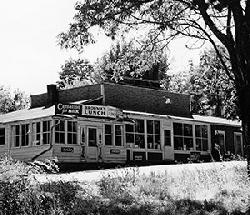|
||||
|
History: From resorts to RVs, an economy of hospitality
9/25/2013 11:48:41 AM
By Karen Johnson
Liberty Lake Historical Society
Just over a century ago, Spokane was crisscrossed with railroads that made her a trade center, Spokane Valley capitalized on its apple orchards and Silver Valley began producing more silver than any other mining district in the USA. What commodities or services propelled Liberty Lake's marketplace a century ago?
Bicycling, Spokane's new fad around the late 1800s, brought pedalers to Liberty Lake's west shore for relaxation. Roderick MacKenzie, a young cattleman settling the west side, and his wife often fed the hungry cyclists. The obvious business opportunity led to a restaurant selling 35-cent chicken dinners. A 20-room hotel was added the following year. Across the lake, another cattle rancher, Martin Kalez, recognized he could market the waterfront of his large ranch, and it soon became a camping resort known as Kalez Park. Success prompted the addition of a store and restaurant. These were the first two resorts on the lake, each reaping a profitable income and encouraging a welcoming lake lifestyle.
Fields just off the lake became orchards, farmlands and ranches through the hard work of homesteaders. Refreshment came through Saturday night hillbilly music and dancing at the nearby township of Spokane Bridge, whose proximity just east of Liberty Lake's State Line border made it accessible to them. In the wintertime, 20 or so couples could nest in large horse-drawn, hay-filled sleighs that glided from Liberty Lake over the river and through the woods to Newman Lake, then back to Spokane Bridge for dancing.
Just after the calendar turned to a new century, Emmett Denison, who lived by the rail line near Liberty Lake, met the train at the Liberty Lake Junction Depot offering to take passengers lakeside on his horse-drawn stage for 25 cents. Soon, the railroad got into the resort business, building a spur line in 1907 from the junction to its company-owned Liberty Lake Park, which was marketed to the larger Inland Empire community. No other lakes had such accessibility.
Ultimately, entrepreneurs moved to Liberty Lake to build more resorts: Zephyr, Neyland's Grove, Dreamwood Bay, Wayside, Ted Weeks, Sandy Beach and Sig's. Some began as a store, some rented swimsuits and boats, rooms and cabins, and offered pleasure boat tours. Several provided restaurants, music and dancing. A confectionary here, a casino there … even a boys' camp. Eventually gas pumps became available dockside. This was lake life at its finest.
|
Did you know?
• Many lake families routinely had their milk delivered by Valley-operated Early Dawn Dairy, purchased produce and meats from Veradale's Renfro's and Rice's Meat Packing, respectively, and shopped for a variety of other goods and services at Greenacres Shopping Center.
• During Expo 74, Valley View's restaurant would often have two- and three-hour waits serving large tour groups staying at the RV park. It also served breakfast to Russian ballet dancers and the Canadian Mounted Police, who stayed next door in motorhomes while performing at Expo 74.
• Holiday Hills was once the prize date package awarded to a lucky couple on ABC's popular '70 s game show, The Dating Game.
• The city of Spokan Falls (the "e" was added in 1883 and "Falls" dropped in 1891) was officially incorporated as a city of about 1,000 residents in 1881. With the arrival of four major railroads, the population soared to 104,000 by 1910, luring settlers from as far away as Finland, Germany and England. Spokane thus became the commercial center of the Inland Northwest over its rival, Walla Walla.
• Riverfront Park in downtown Spokane was formerly dominated by railroad depots and junky warehouses, relocated to make way for the site of Expo 74.
The Development of a Community
A series from the Liberty Lake Historical Society, appearing in the first Splash issue of each month in 2013. January - Relocation of the Coeur d'Alenes
February - Formation of the Coeur d'Alene Indian Reservation
March - Transportation Overview
April - Railroads
May - Homesteaders
June - Homesteaders in the hills
July - Utilities
August - Church
September - School
October - Commerce
November - Government
December - Medical
|
Ernest Wright opened a general store in "downtown" Liberty Lake (Melkapsi and Wright) around 1910, which changed hands several times through the years. By mid-century, T.O. "Brownie" and Bertha Brown owned and operated Wright's store, affectionately known as Brownie's. I remember scavenging for empty pop bottles on the beaches at the resorts to trade for penny candy at Brownie's. As I shared this recently with Brownie's granddaughter, Janis, we laughed when she confessed she was slyly "scavenging" the collected empty pop bottles Brownie stored by his back door, also trading them in for candy. Of course, her grandpa knew what was happening all along!
As the automobile became the choice mode of transportation, the possibility of exploration became a reality, and Liberty Lake's shores lost their exclusivity. Although the visitor population waned, a growing residential population demanded more businesses, supplies and services. In the latter part of the century, many of the community's original revenue-producing commodities, including the resorts, began phasing out. The original homesteaders' farmland and orchards, which had largelybecome bluegrass fields for seed production, now gave way to a new fiscal opportunity: golf. Liberty Lake Golf Course, constructed in 1959, became a new lure for the community. In 1973, Valley View Golf Course (now Trailhead) was developed as the first mid-length executive course in the Northwest. MeadowWood Golf Course, 1987, rounded out the triple golf package, thrusting Liberty Lake to the status of a premier golf course community.
At the same time Expo 74 was revitalizing downtown Spokane, Liberty Lake experienced its own surge of energy when Carlson Hill (Legacy Ridge) was renamed Holiday Hills and opened as a ski and snowmobile recreation destination with a lodge and restaurant. Later, the site accommodated equestrian activities, snowmobile and motocross racing, youth sports camps and ice skating. Its lodge burned down in 1998, more than a decade after the site had closed. The flat area below it (today's southwest corner of Country Vista and Liberty Lake Roads) had become an RV Park in those days with 500 rentable Expo-colored RVs.
So what commodities or services were responsible not only for propelling Liberty Lake to stability through its early years, but for maintaining its character and inviting hospitality through generations? Certainly our amazing, natural environment pops quickly to mind. But the tireless efforts, fiscal creativity and absolute generosity from generations of neighbors must top the list. Liberty Lake continues to market itself as a hot commodity, and her people are her greatest assets. The real question is: What am I responsible to contribute toward Liberty Lake's unique legacy?
Karen Johnson is a longtime resident and Liberty Lake Historical Society board member.



